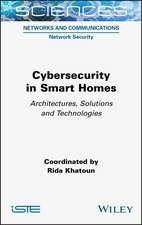Resource Management for On–Demand Mission–Critical Internet of Things Applications: IEEE Press
Autor J Farooqen Limba Engleză Hardback – 7 oct 2021
RESOURCE MANAGEMENT FOR ON-DEMAND MISSION-CRITICAL INTERNET OF THINGS APPLICATIONS
Discover an insightful and up-to-date treatment of resource management in Internet of Things technology
In Resource Management for On-Demand Mission-Critical Internet of Things Applications, an expert team of engineers delivers an insightful analytical perspective on modeling and decision support for mission-critical Internet of Things applications. The authors dissect the complex IoT ecosystem and provide a cross-layer perspective on the design and operation of IoT, especially in the context of smart and connected communities.
The book offers an economic perspective on resource management in IoT systems with a particular emphasis on three main areas: spectrum management via reservation, allocation of cloud/fog resources to IoT applications, and resource provisioning to smart city service requests. It leverages theories from dynamic mechanism design, optimal control theory, and spatial point processes, providing an overview of integrated decision-making frameworks.
Finally, the authors discuss future directions and relevant problems on the economics of resource management from new perspectives, like security and resilience. Readers will also enjoy the inclusion of:
- A thorough introduction and overview of IoT applications in smart cities, mission critical IoT services and requirements, and key metrics and research challenges
- A comprehensive exploration of the allocation of spectrum resources to mission critical IoT applications, including the massive surge of IoT and spectrum scarcity problem
- Practical discussions of the provisioning of cloud/fog computing resources to IoT applications, including allocation policy
- In-depth examinations of resource provisioning to spatio-temporal service requests in smart cities
Perfect for engineers working on Internet of Things and cyber-physical systems, Resource Management for On-Demand Mission-Critical Internet of Things Applications is also an indispensable reference for graduate students, researchers, and professors with an interest in IoT resource management.
Din seria IEEE Press
- 60%
 Preț: 251.98 lei
Preț: 251.98 lei - 50%
 Preț: 401.99 lei
Preț: 401.99 lei - 24%
 Preț: 612.64 lei
Preț: 612.64 lei - 24%
 Preț: 707.87 lei
Preț: 707.87 lei - 24%
 Preț: 702.62 lei
Preț: 702.62 lei - 14%
 Preț: 728.42 lei
Preț: 728.42 lei - 24%
 Preț: 546.23 lei
Preț: 546.23 lei - 24%
 Preț: 706.11 lei
Preț: 706.11 lei - 24%
 Preț: 667.14 lei
Preț: 667.14 lei -
 Preț: 517.44 lei
Preț: 517.44 lei -
 Preț: 496.42 lei
Preț: 496.42 lei - 24%
 Preț: 618.96 lei
Preț: 618.96 lei - 24%
 Preț: 617.44 lei
Preț: 617.44 lei - 24%
 Preț: 600.44 lei
Preț: 600.44 lei - 24%
 Preț: 741.52 lei
Preț: 741.52 lei - 20%
 Preț: 446.57 lei
Preț: 446.57 lei - 24%
 Preț: 572.09 lei
Preț: 572.09 lei - 24%
 Preț: 1226.90 lei
Preț: 1226.90 lei - 24%
 Preț: 704.87 lei
Preț: 704.87 lei -
 Preț: 1280.69 lei
Preț: 1280.69 lei - 24%
 Preț: 672.03 lei
Preț: 672.03 lei - 24%
 Preț: 695.85 lei
Preț: 695.85 lei - 14%
 Preț: 841.42 lei
Preț: 841.42 lei -
 Preț: 415.98 lei
Preț: 415.98 lei - 9%
 Preț: 989.74 lei
Preț: 989.74 lei - 9%
 Preț: 1469.48 lei
Preț: 1469.48 lei - 9%
 Preț: 789.77 lei
Preț: 789.77 lei - 9%
 Preț: 1094.79 lei
Preț: 1094.79 lei - 20%
 Preț: 708.56 lei
Preț: 708.56 lei - 9%
 Preț: 905.12 lei
Preț: 905.12 lei - 9%
 Preț: 973.88 lei
Preț: 973.88 lei - 9%
 Preț: 944.00 lei
Preț: 944.00 lei - 9%
 Preț: 1929.96 lei
Preț: 1929.96 lei - 9%
 Preț: 1047.81 lei
Preț: 1047.81 lei - 9%
 Preț: 727.86 lei
Preț: 727.86 lei - 9%
 Preț: 1000.55 lei
Preț: 1000.55 lei - 9%
 Preț: 1455.68 lei
Preț: 1455.68 lei - 9%
 Preț: 999.59 lei
Preț: 999.59 lei - 9%
 Preț: 911.48 lei
Preț: 911.48 lei - 9%
 Preț: 977.48 lei
Preț: 977.48 lei - 9%
 Preț: 950.89 lei
Preț: 950.89 lei - 9%
 Preț: 765.35 lei
Preț: 765.35 lei - 9%
 Preț: 990.35 lei
Preț: 990.35 lei - 9%
 Preț: 1009.47 lei
Preț: 1009.47 lei - 9%
 Preț: 799.35 lei
Preț: 799.35 lei - 9%
 Preț: 1107.40 lei
Preț: 1107.40 lei - 9%
 Preț: 1529.07 lei
Preț: 1529.07 lei - 9%
 Preț: 1263.15 lei
Preț: 1263.15 lei - 9%
 Preț: 1015.75 lei
Preț: 1015.75 lei - 9%
 Preț: 1107.71 lei
Preț: 1107.71 lei
Preț: 790.68 lei
Preț vechi: 868.89 lei
-9% Nou
151.32€ • 157.18$ • 125.69£
Carte tipărită la comandă
Livrare economică 03-17 februarie 25
Specificații
ISBN-10: 1119716098
Pagini: 224
Dimensiuni: 166 x 246 x 18 mm
Greutate: 0.47 kg
Editura: Wiley
Seria IEEE Press
Locul publicării:Hoboken, United States




























